One of the biggest surprise packages of this Serie A season must be Fiorentina, who barely finished 13th last season. However, the team did not slow down and showed their ambition by signing new players such as Nicolás González, Igor, Lucas Torreira and Álvaro Odriozola. Apart from the recruitment that strengthened their squad, another important part of their revolution has been the new head coach: Vincenzo Italiano, who arrived from Spezia Calcio during the summer.
Italiano was a former player who spent many years at Hellas Verona. After his retirement, he began his managerial career as an assistant at Venezia. After bringing Trapani to Serie B, Italiano attracted interest from Spezia and also led them to the top-tier in Italy for the first time in the club’s history. He was highly praised for keeping the team up in their debut Serie A season as well. These success stories earned the 44-year-old head coach a chance to manage a bigger side, and he signed a two-year contract with Fiorentina.
This tactical analysis will give a detailed profile of how Italiano structures his Fiorentina team. Of course, he has clear principles of play but he’s also a coach who tweaks his tactics according to his players and opponents.
Offensive organization
Italiano’s Spezia spent more time defending but it’s been a bit different at Fiorentina. With players having higher quality, he wants his team to opt for more control during the attack to dictate the opposition. Hence, they are more patient in the build-up and constructive phases, which is reflected by stats as well. Spezia had 424.64 passes and 52.7% of ball possession in 2020/21, and Fiorentina have 461.13 and 57.4% this season, ranking 4th and 2nd in the league.
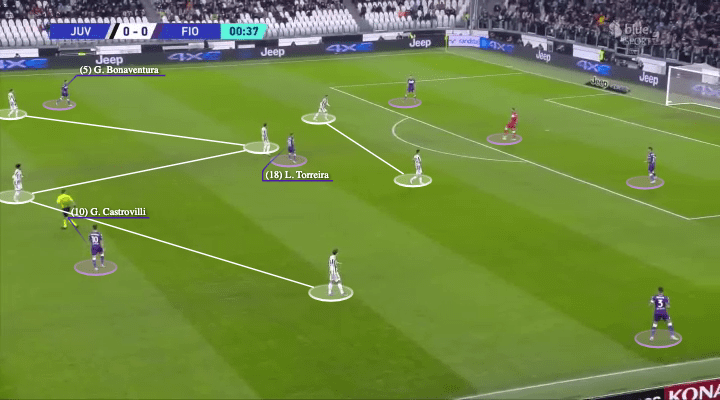
In the build-up, Fiorentina have a pair of wide full-backs and midfielders in their own half, while the front three are staying high to fix the last line, which means I Viola often have five to seven deep players in this phase. The full-backs can be asymmetrically positioned; for example, the right-back was out of the frame of the first image as he occupied higher wide spaces, allowing José Callejón to tuck into the half-space. The lower full-back should always be a lofted diagonal option for the goalkeeper to bypass the press.
Italiano likes the goalkeeper to join the attack in higher spaces, so his side can create a numerical advantage in the first line. In this image, Juventus’s 4-4-2 had two strikers in the first line, and it was a 3v2, while Pietro Terracciano was high enough to be parallel with the centre-backs.
In the midfield, you could consider the build-up shape of Fiorentina as a 2-1 as Torreira was always moving behind the first line, he would not drop between the centre-backs as getting on the ball was not his priority. Instead, the Uruguayan midfielder should be using his positioning and movements to manipulate the defending side, opening spaces for teammates. Fiorentina’s offensive structure was a clean 4-1-2-3 or a 4-2-1-3, Italiano did not want his 8 and 10 to stay too close to each other as the duo should be operating in their respective half to stretch the opposition block. Here, Gaetano Castrovilli and Giacomo Bonaventura were apart from each other to occupy both half-spaces.
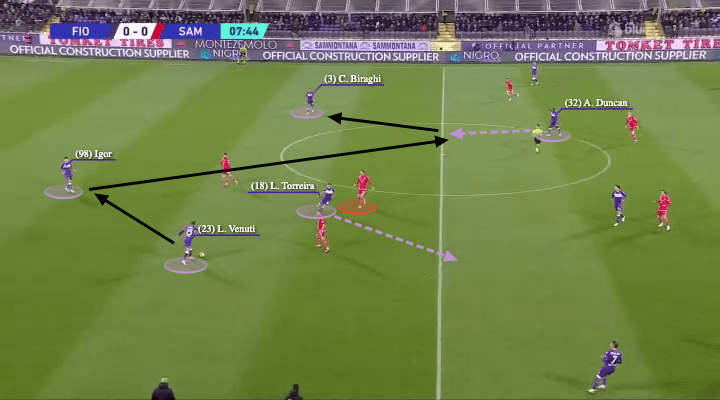
Italiano’s Fiorentina have an offensive structure based on the characteristics of players. They knew Torreira’s good at defending, but his ball-playing is not the best, so the 8 or 10 should be alert to help and drop from higher spaces to support. The second image shows a scenario of I Viola in possession, they are very confident in ball circulation and instead of being too vertical, they tend to break the lines when the condition is met. That means the tempo of his football isn’t too quick, and things are more controlled in the offensive organizations.
Here, everything began from Torreira’s forward movement. Against Sampdoria’s 4-2-3-1, that diagonal move could bring away the man-marker and now the spaces were opened in the centre. Fiorentina usually had two solutions to exploit that area, one was to invert the full-backs slightly as the midfielder, or in this case, Alfred Duncan dropped from the half-spaces to release the third man. As we have drawn with the black arrows, you could see how Fiorentina moved the ball from one half to the other and reached the weaker side, where Cristiano Biraghi could proceed the attack to another phase as there were more spaces to play.
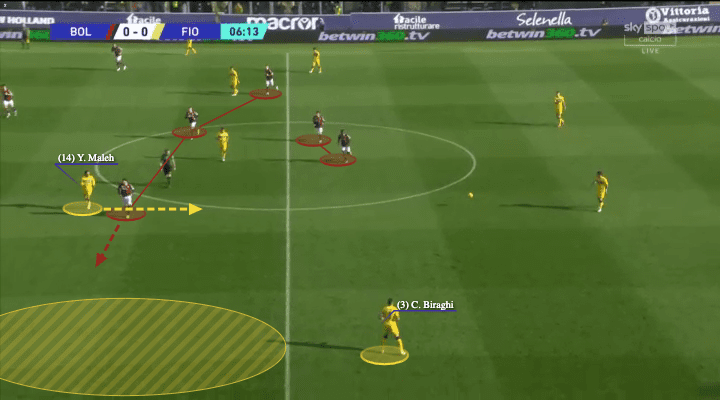
Italiano is flexible and he has different solutions against a back five. Against a 5-3-2 or a 5-1-2-2 such as the one used by Bologna, his side gained an upper hand with the use of deep full-backs. An important concept of his football philosophy is to move behind the opposition, especially the midfielders. Italiano’s midfielders would never stick together in the same horizontal zone as they would lose the dynamic to break lines and counteract. Therefore, you could always spot the 8 and 10 of Fiorentina staying high in the half-spaces, so they could move on the blindside of the opposition to receive by surprise.
Tactically, Youssef Maleh’s position achieved this strategical advantage for Fiorentina in this example. When they moved the ball from side to side, the Bologna strikers were too far to press, so the wide midfielder must jump out. Maleh also dropped to offer a lateral option for his left-back, so the wide midfielder must decide on who to mark, it was a 2v1. However, it was debatable whether Maleh should drop deep, as he was entering the striker’s zone, and kind of nullified the 2v2 eventually, staying in his initial position might’ve been a better option. Fiorentina must improve in adaptation to the complexity of the game.
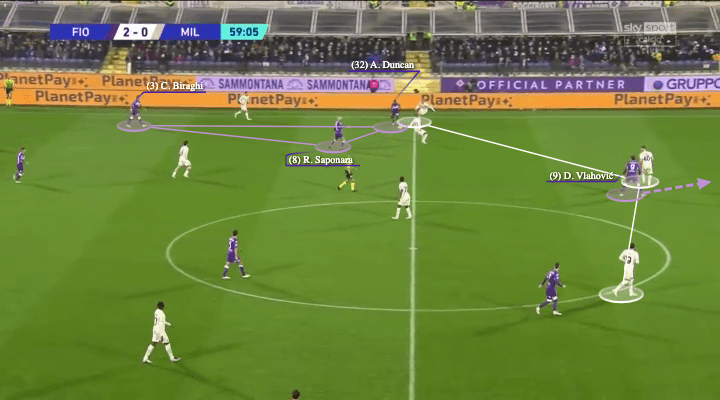
There were also reasons to support the deployment of deeper full-backs in the first and second phases. Firstly, Italiano did not want his shape turning into something like a 2-2-6 or 3-1-6, as that was too exposed in the transitions. Also, it kills the wide spaces to play in the second third and Fiorentina can only go behind, and that is a bit too direct. The deep full-backs can inject the energy when making the forward runs or possibly outpace the winger when reaching the byline. They can also interact with the 8 and winger better as they have more angles and spaces to rotate and pass in deep. Particularly, this fits Biraghi’s style, as the former Inter left-back is very good on the ball.
These tactics also contributed to Dušan Vlahović’s goal against AC Milan. It looked like a simple run in behind that Matteo Gabbia could not defend, but that was also attributed to the structure. Italiano played Riccardo Saponara in that game, who was better in the half-spaces, so Fiorentina rotated more often in that game as Duncan would move out to the winger position more often. That gives the left-back two options, one was the vertical to Duncan and the other was a diagonal to Saponara. Also, since Biraghi’s deep position attracted the right-back, Simon Kjær went out to press Duncan and that created the isolation of Vlahović on Gabbia. This was how the goal was created.
Final passes & chance creations
Apart from the above tactics in the offensive organization, Fiorentina also have good structures in the final third to generate goal threat. Their accumulated 28.81 xG so far is not far from Milan’s 29.21, ranking 6th in the league, which is quite fine given there’s Atalanta, Inter, Napoli, and Milan, and Roma ahead of them — not bad company.
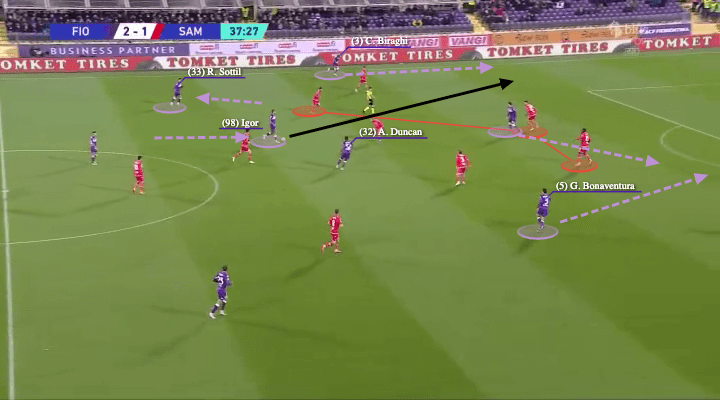
The first image shows their final passes, this was another rotation by the players. In general, Italiano requires his centre-backs to be comfortable on the ball, and Igor is particularly the best ball-playing defender. The Brazilian player is left-footed, which means he’s able to carry the ball forward and Torreira stays centrally to cover him, which is the above scenario.
Also, the likes of Riccardo Sottil or González tend to receive at feet rather than only running into spaces. When the winger drops, they can pull the full-back out and there comes the chance for the Fiorentina to attack spaces outside with the deep runs. Here, Sampdoria’s right-back was caught out of position as he followed Sottil, so when Igor came, he easily spotted Biraghi’s run and released him. Then, it was a crossing opportunity. This was also why the deep run was important as that meant the full-back only had to outrun the winger in these situations. If the full-back was high initially, he also dragged the winger down, which killed spaces.
Meanwhile, the Fiorentina midfielders were staying centrally. Notice Bonaventura’s position, he’s an energetic player who makes so many penetrative runs in the final third. When the cross came, you would expect to see him in the penalty zone, and we shall discuss why this is important to the chance creation through these goals below. Fiorentina are heavily reliant on crossing as they cross 16.56 times per 90 — the third-highest in Serie A so far.
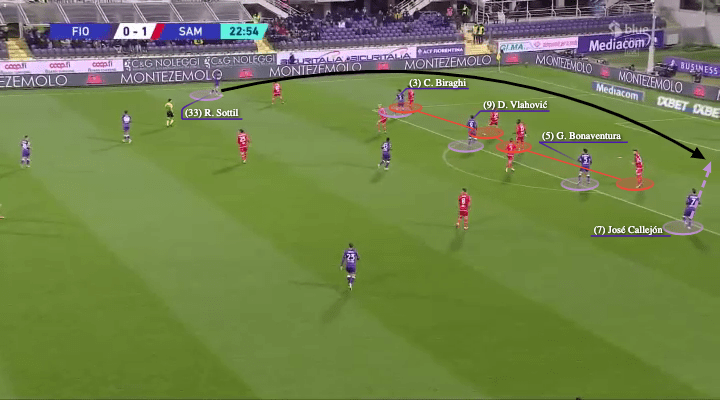
The first one was the equalizer in the Sampdoria victory. It was an in-swinger that went to the far post, resulting in a simple tap-in by Callejón, but the tactics behind this goal were great. Fiorentina always commit many players when attacking in the offensive third, this would push the last line down. The distribution of players was important too since that flattened structure means they were stretching the defenders horizontally to enlarge each gap, meaning each defender was required to defend more spaces.
Since the wingers would come out to receive and play in a deeper role, the full-backs, especially Biraghi, would go high to attack the box, occupying one defender at least. Then, with Vlahović, and Bonaventura who always stayed high, they had another two. Note that the positions of players were vital as well, they should not stick to one opposition. Instead, they should achieve positional superiority by tucking between the defenders, so sometimes one attacker could take two defenders and Vlahović provided a great example of this in that goal. Then, Callejón, as the far side winger, just made the blindside diagonal run and finish.
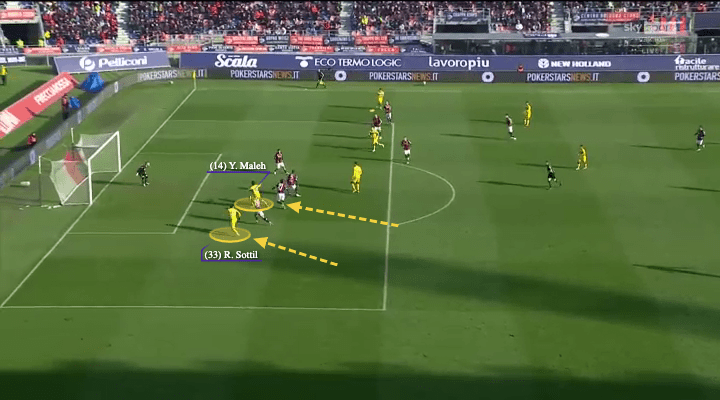
The goal against Bologna shows something very similar. The context was different, but the movements were a mirror of the Sampdoria goal. When Italiano played wrong-footed wingers, they always delivered the in-swingers and there were always players to attack the penalty zone.
Here, Sottil was the far side winger who made the diagonal run on the blindside. This time, the right wing-back of Bologna was aware of Sottil and he was orienting himself towards the winger. However, the real receiver was Maleh, who made the deep run as the midfielder and sneaked in front of him to convert. You can also interpret the situation as the far post overload, as there was always a 2v1 to perplex the last defender, and the deliveries always went to that area.
Pressing & blocks
Offensively, Fiorentina are dominant in possession as they move the ball well with clear principles of play and structures. Defensively, we see some Carlo Ancelotti in Italiano, while there is also some pressing from the former Spezia head coach. His tactics are flexible to allow his side to adjust the angle of the press, the numbers committed in the press and spaces to press according to the different opponents. In this section, we included as many variants as possible of Fiorentina’s press to show Italiano’s core defensive principles.
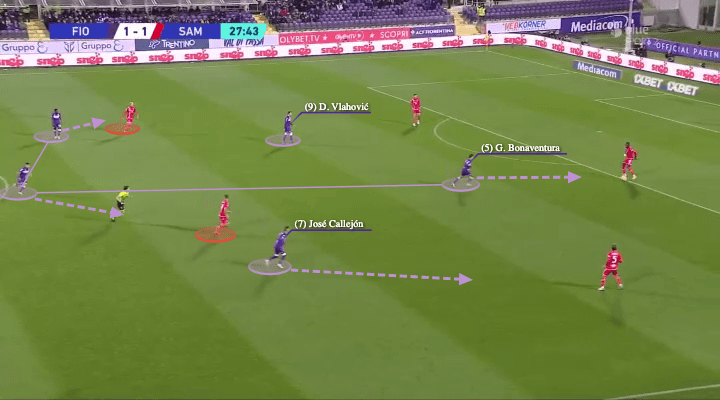
Recently, Fiorentina have preferred to press with four players in the centre (3 MF + 1 ST). Against Sampdoria’s 4-2-3-1, when the opposition played out with four deep players, it was a 4v4 as we have shown above. The 8 or the 10 would jump out to press the centre-back vertically, while Vlahović mainly stayed to cut the exchange passing lane as Italiano would have wanted him to preserve energy for the transitions. Then, Torreira always went up to support the press and, in this case, he and Duncan both controlled one opposition midfielder.
Italiano’s pressing is built on central protection. Initially, they mostly keep their engagement line out of the penalty box as they do not want to be stretched vertically. The first pass must not go into the block, and when the opponent passes the ball wide, it’s a trigger for the wingers to press diagonally. Of course, initially, the winger should be a bit deeper and narrower to cover the centre, just as Callejón did here. When they pressed, the run must be direct and not curving to cover, that is a symbol of the intensity of their defence.
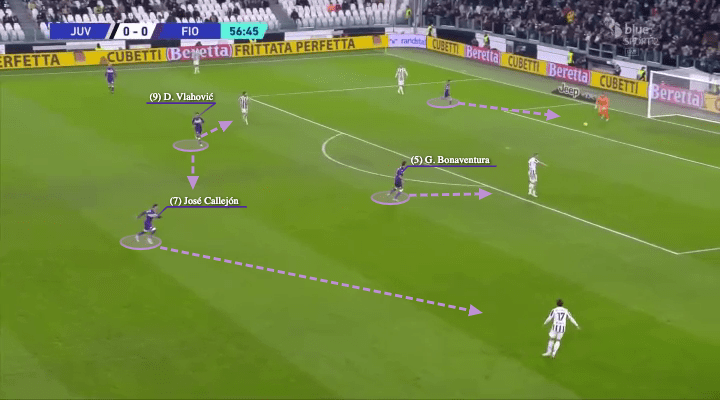
This one against Juventus was very similar. Italiano expects his midfielders, especially the 8 and 10, to be energetic as they are covering huge grounds both offensively and defensively. Here, they pressed the goalkeeper as going all the way after a backward pass was their principle of defending. Again, Bonaventura went up to match the centre-back with Vlahović, it was a 2v2, so Mattia Perin could not go into the centre. Then, It was Callejón again to press the left-back diagonally from the centre, and it would be successful when the defender dropped back to control the lofted ball from the keeper.
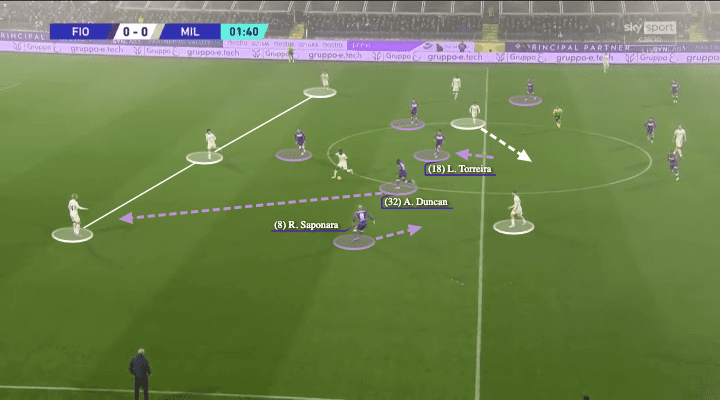
Another situation here against Milan shows the emphasis on central protection. Specifically, this game shows how Fiorentina used the central players to press, and usually, the wingers stayed narrower and lower to provide balance to the defensive structure. Milan’s Sandro Tonali dropped between the defenders to form a temporary back three, so Vlahović just stayed close by to cut the lateral passing lane while being a bit closer to the midfielder.
The player to initiate the press was usually the midfielder. Here, Duncan went to press the defensive midfielder, then there was a backward pass and he went all the way to press Kjær too. Notice left-winger Saponara’s defensive behaviour. His first move was to get a bit narrower to cover the vertical option in the half-space, it shows how Italiano hates to let the opposition play inside.
But there was a small problem in this 4-1-2-3 block. Since Torreira always goes up to support the press, spaces in front of the last line might be exposed. This requires the centre-back to be able to step up and close that space when necessary, as the wingers might not be tracking the runners inside.
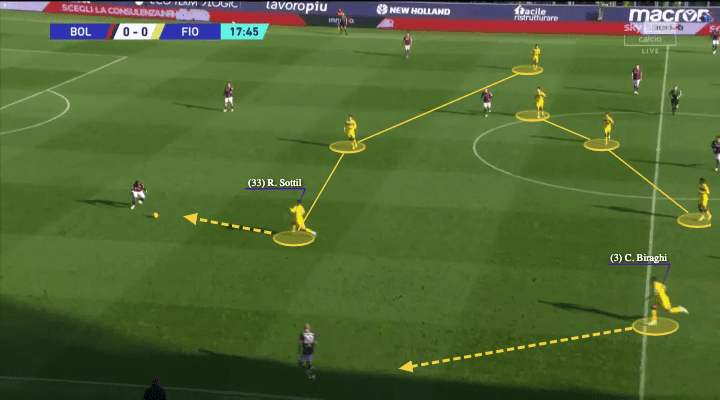
Against a back five, Fiorentina’s pressing is a bit different, as they then face three central defenders. They use the front three to match the back three as we showed in this example against Bologna. Vlahović just had to do the same as he did in the Milan example — stay central and cut the exchange passing lane. Sottil, the left-winger, would be pressing the right centre-back, and the full-back (Biraghi) must come up to close down the wing-back. In general, I Viola also maintain compactness in the centre, with all three midfielders dominating those spaces on the inside so Bologna could not play through them.
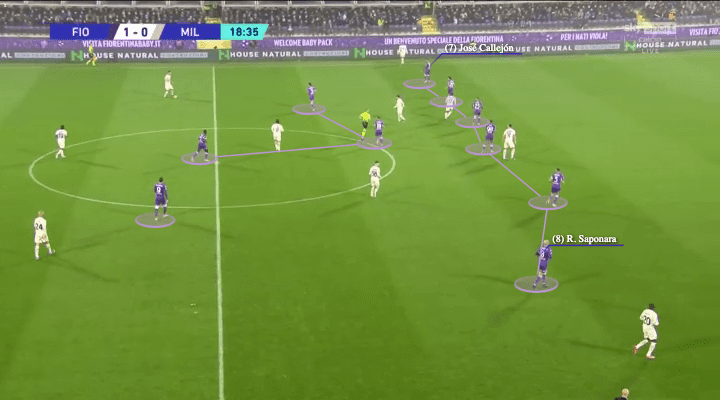
Against some opponents like Milan, Fiorentina might even lower the engagement further to keep the defence tight as a unit. For situations in which a mid/low block is set, the wingers are required to defend deeper as they provide cover in the pressing. In this case, they kept the pressing intensity in the centre as the midfield trio could go out to press, and the wingers were defending the outside spaces for the full-backs so the last line was staying tight. This minimized the gap between each defender and denied the through passes, which helped them to protect the spaces behind. In general, the shape would be a 6-1-2-1 or a 6-3-1.
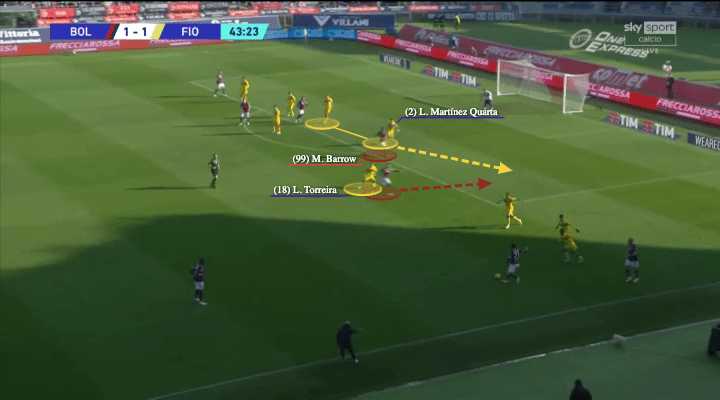
There’s also an issue in their defence around the penalty zone, Fiorentina have an issue against the deep runs and we’re not sure about Italiano’s exact instructions. The midfielders tend not to track the runs too deep, they just defend spaces and ask for shifting. For example, in this case against Bologna, Torreira gave up the run and let Lucas Martínez Quarta cover. However, then the backline was broken as the Argentine defender got away from the initial target. While the spaces were too big to cover and he could not block the cross, he also let Modou Barrow get free and become dangerous, as now the gap between the central defenders was enlarged.
Transitions
Since Fiorentina are more patient in their offensive organization, they control the game better but there also have several weaknesses in the defensive transitions.
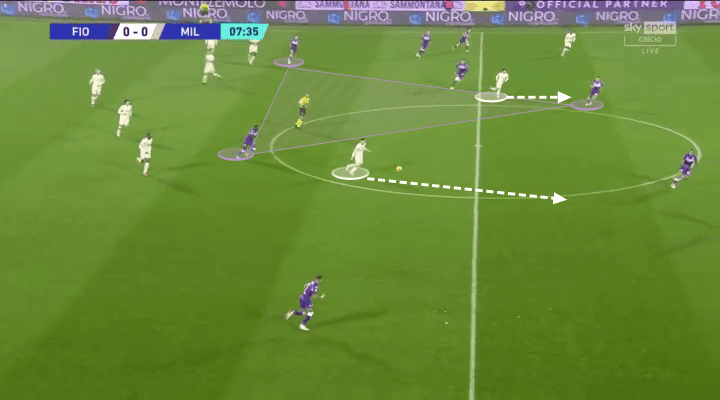
Firstly, it’s because of their spacing in the midfield and the link between their midfielders. Most of the time, Torreira is deep and the other two are high or drifted wide. The midfield trio does not stay together and given the full-backs are often wide, they can’t immediately capture the ball when the progression’s interrupted in the middle third. For example, in this case against Milan, the structure was exposed as Bonaventura and Duncan were too high, and Torreira could not apply the first time pressure as he was deep initially. Therefore, the central defenders tended to delay and retreat instead of engaging early. They needed to slow the attack down and wait until everybody was back to defend together as a unit.
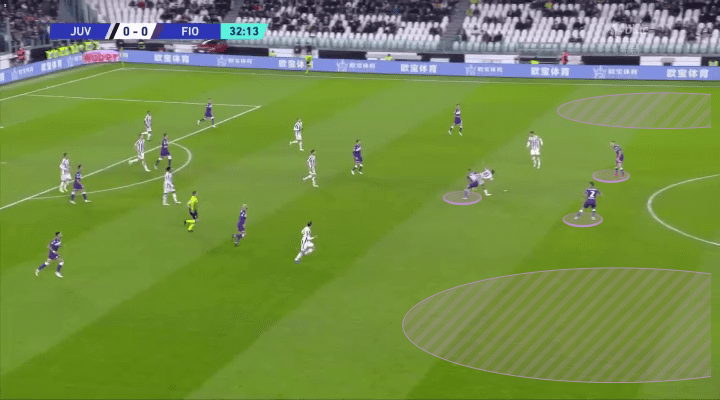
Usually, their rest defence structure would be a 2-1 shape formed by centre-backs and the 6. That means they were conceding spaces behind the high and wide full-backs, and these can be exploited by the opposition, as we have indicated in the last image.
Conclusion
As we explained in this analysis, Italiano and his Fiorentina would be an interesting side to watch in 2022. So far, they showed their tendency to insist on their playing style regardless of the position of the opposition. Players such as González, Vlahović, Sottil, Nikola Milenković have all thrived and handed in strong performances, it would be a successful season if the troops could carry on the form to the new calendar year, and I Viola might even return to Europe after missing out for more than five years.
While Italiano has a two-year contract with the team, it probably won’t be his last club in Italy. If I Viola continue achieving results and beating top teams in the league, bigger clubs will come for him, and he shall have a bigger platform from which to show his work.

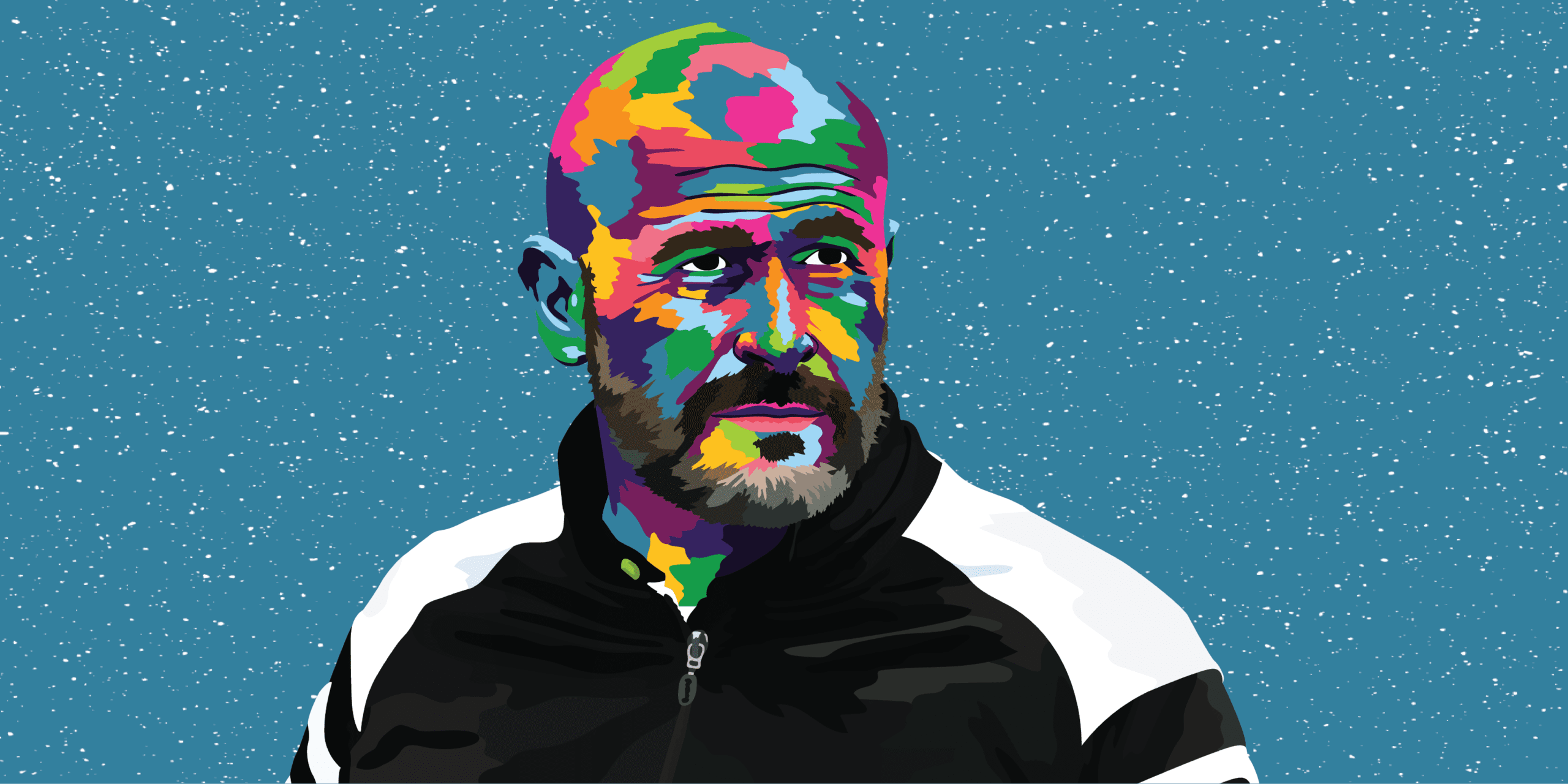



Comments